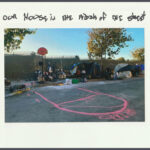Have you ever dreamt of traveling the world to witness the most exotic bird species in their natural habitats? Imagine spotting Torrent Ducks in the Peruvian Andes, observing an Ivory Gull amidst the Arctic ice, or marveling at a Black Kite in the Australian outback – all in a single week. For many bird enthusiasts, this might sound like an impossible fantasy, requiring extensive travel, time, and resources. However, there’s a revolutionary way to achieve this, and it’s more accessible than you might think. Welcome to the world of Google Street View birding.
Yes, you read that right. You can now embark on incredible birding expeditions without leaving the comfort of your home, thanks to Google Street View. This remarkable feature within Google Maps offers a vast collection of panoramic images, allowing users to virtually traverse over 10 million miles of streets and trails across more than 80 countries. Initially designed for navigation and exploration, Google Street View has unlocked a surprisingly engaging and innovative avenue for birdwatching.
When Google Street View first emerged in the late 2000s, many of us were curious to see our own homes or familiar streets. The author, like many others, initially tried to spot themselves in front of their house. However, a different path unfolded for some. Instead of simply closing the window and moving on, a dedicated community of birders began to explore the virtual landscapes for avian life. This marked the beginning of Google Street View birding, a unique blend of technology and nature observation.
The allure of Google Street View birding lies in its inherent challenges and unexpected rewards. While the real world is teeming with birdlife, the virtual scenery can often feel empty and devoid of movement. Navigating through digital roads, painstakingly clicking and dragging to pan the camera, the quest to find a perched bird on a wire or fencepost becomes a patient and persistent endeavor. When a bird is finally spotted, it often appears as a small, indistinct blob, testing the limits of the Street View camera’s resolution. Adding to the complexity, the temporal aspect of image capture means that a bird in flight might vanish in the subsequent frame, creating a fleeting and sometimes frustrating experience.
Despite these challenges, the thrill of discovery keeps Google Street View birders coming back for more. Early successes, such as spotting Laughing Gulls in Florida and a Great Egret in Texas back in 2013, fueled further exploration and inspired shared discoveries online. Blog posts documenting these virtual sightings began to surface, showcasing the potential of this new birding frontier. As Google expanded its Street View capabilities with backpack-mounted cameras for pedestrian pathways, even more incredible captures emerged from remote locations like Midway Atoll and the Falkland Islands. Dedicated virtual trips to Mexico, Florida, and other bird-rich destinations further solidified Google Street View birding as a legitimate and engaging activity.
Chinstrap Penguins, Baily Head, Antarctica.
Initially, Google Street View birding felt like a solitary pursuit. However, recognizing the potential for community and collaboration, the creation of a dedicated Facebook group transformed the landscape. The “Google Street View Birding” Facebook group, launched in early November, became a hub for enthusiasts to connect, share findings, and collectively explore the virtual world for birds. The response was overwhelming.
Within weeks, hundreds of birders joined the online community, eager to contribute to the shared endeavor of scouring millions of Street View miles. The collective effort quickly surpassed individual capabilities. While a single birder might only identify a few common species like large herons, gulls, and Rock Pigeons, the community rapidly expanded the virtual life list. To date, members have identified over 580 different species through Google Street View, representing approximately 5% of all bird species on Earth. The Facebook group became a dynamic forum, filled with screenshots, links, and lively debates surrounding bird identifications from often grainy and distant images.
The sheer scope of the virtual searches and the collaborative detective work involved in identifying birds has been truly remarkable. The community has collectively spotted over 30 gull species, including the stunning Ivory Gull in Nunavut. Other notable finds include Kelp Geese in the Falklands and Laysan Ducks on Midway Atoll. Majestic birds of prey like Bald Eagles in Texas and both California and Andean Condors have also been virtually sighted. Remarkably, even smaller bird species, such as a Vermilion Flycatcher in the Galapagos and a Rufous Hummingbird in Alaska, have been identified, showcasing the keen eyes and dedication of Google Street View birders. Each sighting is meticulously documented with a screenshot and a Google Street View link, allowing group members to verify identifications and contribute to the ongoing virtual birding expedition.
Vermilion Flycatcher, Galapagos.
For those skeptical of identifying birds from low-resolution Google Street View images, the reality is that it mirrors many aspects of real-world birding. Birders frequently grapple with blurry photos and distant sightings when trying to identify species in the field. The Facebook group environment replicates this experience, fostering discussions and collaborative identification efforts, albeit in a low-stakes, purely enjoyable setting. It’s a testament to the power of online communities and the shared passion for birding that transcends geographical boundaries.
If you’re intrigued by the prospect of virtual birding, joining the Google Street View Birding community is easy. While the group is always welcoming new members, keep in mind that the focus is increasingly shifting towards finding new and rarer species as the more common ones are gradually documented. New members can consult a shared Google Spreadsheet to track already identified species and target their searches accordingly. Beyond birds, the group also playfully documents sightings of birders captured by Google Street View cameras, other animals, and even birds featured on signs or artwork, adding layers of fun and discovery to the virtual exploration.
To embark on your own Google Street View birding adventure, there are essentially two approaches. You can either explore specific locations known for their rich birdlife or simply wander virtually along roads and trails anywhere in the world, keeping your eyes peeled for avian sightings. When you stumble upon a new bird, capturing a screenshot and sharing it with a Google Street View link in the Facebook group allows you to contribute to the collective knowledge and bask in the shared excitement of virtual birding discoveries.
Google Street View birding offers a unique and engaging way to explore the world and connect with nature from anywhere. It’s a testament to human curiosity, community collaboration, and the ever-evolving possibilities of technology in enriching our passions. So, why not give it a try? Your next birding adventure might just be a few clicks away.


